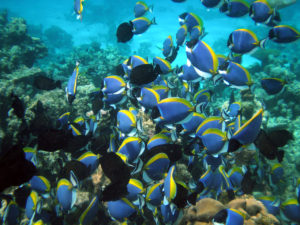When buying a new fish, it is always a concern for fishkeepers if the fish they are buying is compatible with the current fish they have. While they are eager to purchase new fish, they have to make sure these new fish will coexist peacefully with the others and not create trouble. This is one thing they should give considerable thought before actually purchasing the fish right in front of them.
Of course the best thing is to first do research about the fish, or ask experienced fish-keepers for their opinion. However, if you are already in a fish store and at that moment, this fish has you drooling with excitement, then you have to do your own assessment and decide if this fish is actually compatible with your current collections.
Experience and knowledge are valuable assets to your decision-making. But whether you are an experienced fishkeeper or a relatively new one, it is best to assess the compatibility of a fish on the following bases:
• Temperament
• Size
• Water preferences
• Competition for food

THE GOOD GUYS AND THE BAD GUYS
Temperament innate to a certain fish is probably the most important concern in determining the compatibility of a new fish with your current collection. Some fish are as amiable as church boys while others are as brash as street corner thugs.
Fish have varied degrees of mildness or aggressiveness in temperament. Thus, your knowledge of the temperament of the new fish will be very important. If you have a chance to do research on this fish, then it should be a good thing. But if you cannot do research, observe its behavior in its current tank. Check if it is the aggressor or if it is being bullied.
Let’s face it: some fish are peaceful and will generally not bother other tank inhabitants. Tetras, goldfish, Corydoras catfishes, rainbow fish, Rasboras, Danios, mollies, guppies, swordtails, platies, Kuhlii loaches, dwarf cichlids, and some plecos, among others, are examples of common fish that very well-mannered. These are not aggressive at all with other tankmates. These are the good guys and generally will not even bother others.
The next set of fish is still relatively peaceful; they can be slightly aggressive but can coexist with others in a community tank. While you can’t say that these fish are well-mannered, they do not make trouble, or at best, they avoid trouble. Examples of these are some barbs, gouramis, angelfish, bala sharks, tinfoil barbs, silver dollars, the hooks, flagtails, clown loaches, fire eels, bichirs, stingrays, etc. These are like your average citizens who live in the community peacefully with others.
The next group of fish are aggressive and have a temper: they are tough, aggressive, and territorial. You must know the extent of their aggressiveness if you are to mix these fish with others. The bigger they are, the more aggressive they are. Cichlids which are well known for their aggressiveness belong to this group. Other fish like arowanas, Indo tigerfish, peacock basses, Payaras, African tigerfish, most catfish, Pacus, knifefish, Golden Dorados, Wolf Fish, Gars, and their ilk are the tough boys and they can live with others so long as the community is a tough one. At the extreme end of these groups are the highly aggressive fish. These fishes simply cannot be housed in a tank with other fish. These legendary monsters will kill tankmates. The red snakehead, lungfishes, Aba Aba knifefish, wolf cichlid, and the meanest of them all, the Aimara wolf fish, cannot be trusted with tankmates. If you want to buy any of these and keep them with other fish, save yourself the trouble by not even considering them. If you should get these, better provide them with a tank of their own; after all, in our society, maximum security prisoners are left in solitary confinement.
To avoid trouble when buying a new fish for an existing tank, keep fish with similar temperaments among themselves and avoid mixing the gentle ones with the aggressive ones. If it is a peaceful community you want, stick with the good guys. If it is a tough neighborhood, you have to keep the tough guys. But never mix both because it will just be trouble.
It is also important to note that aggression among young fish may not be evident, but some meek baby fish grow into matching monster demeanors as they grow bigger. Well-behaved cuties like the juvenile Red Snakehead grow to become monsters when they bulk up. So it does not necessarily mean that if you are able to keep them together while they are young, the tank will still be peaceful when they grow up. At a certain age, their natural instincts to be aggressive will be evident.

SIZE MATTERS
This is a basic concept which is 95% correct. Size matters when it comes to fish, with the basic logic being, big fish eat little fish. Except for the Gulper catfish, and maybe a few more species we are not aware of, the big fish will always have the tendency to eat the little fish. As we all say, if it fits in the mouth, then it is food. This is especially true with carnivorous fish; after all, they are made to eat meat, including fish meat.
Thus, introducing a fish small enough to be eaten is a risk; this fish will eventually be eaten. It doesn’t matter which species this is; even a small piranha, known for its aggressiveness, will be eaten by a large predatory fish.
In fact this reminds me of a fellow who set up a huge tank. When finding out which monster fish to keep, our rule was to omit any monster fish capable of eating a 12 to 15 inch fish. Thus, large and notorious fish eaters like the arapaima, red-tailed catfish, tiger shovelnosed catfish, Paroon sharks, Nile perch, and Wallago catfish were not considered.
Unfortunately, in his excitement, he bought some 15 to 16-inch peacock bass. On the day that his 7-inch Payara and Goliath African Tigerfish were released in the tank, the large peacock basses simply gobbled them up. It took less than a minute for the huge peacock basses to locate the two notoriously aggressive Tetras and have them for dinner. While adult Payara and Goliath African tigerfish are more aggressive than adult peacock basses, as juveniles, they are not that yet aggressive compared to an adult peacock bass. Since they were the smaller fish, they were definitely at risk to of being eaten by a carnivore twice their size.
If a fish is not eaten because of its relatively smaller size, they are still in danger of being bullied. An aggressive fish that has taken territory in a tank will always bully a newcomer. If the newcomer is bigger, then the resident bully may think twice. But if the newcomer is smaller, it will most probably be attacked by the resident bully. A bullied fish will always be stressed out in the tank, to the point it cannot eat, will weaken, and eventually die.
Yes, size does matter in the fish world. Therefore, in purchasing new additions to an existing tank, the size differences should not be great. Make sure your fish are of similar sizes. Don’t even consider buying a fish that is too small for your community, unless of course you have another tank reserved for growing out small fish.
SIMILAR WATER REQUIREMENTS IS A MUST
This may not be too much of a concern with most fish. But if you are collecting the more challenging fish which have specific water parameters like pH, hardness, and temperature, then your choice of new additions should be governed by the same water parameters.
Altum angelfish are one such example. For decades, they have been the dream of advanced fishkeepers, but until today, they are still very challenging to keep. Wild caught Altum angelfish from the jungles of the Amazon require very acidic pH, very soft water, and warm temperatures. If you are to keep them, these parameters must be kept stable. Therefore your choice of additional fish should likewise have these requirements. Luckily, there are many choices of tetras and dwarf cichlids available which share the same needs.
For the sake of giving an example, adding a wild caught cichlid from Lake Tanganyika—which has water parameter needs that are the exact opposite to those of the Altum angelfish except for temperature—is a bad decision. This of course will never happen because only advanced fishkeepers would have a fascination with the Altum angelfish, and they know it will be a mistake to do so.
In the country, a couple of subtropical aquarium fish are available to fishkeepers. The Sterlet sturgeon, paddlefish, Golden Cobra snakehead, and rainbow snakehead are just some of the coldwater fish available to Filipino fishkeepers living in the tropics. If you are to add any of these to your collection of tropical fish while keeping your tank at tropical temperatures of 27 to 32 °C, don’t tell me I didn’t warn you. These fish will only have a difficult time surviving your tank conditions. To keep these, your tank conditions must be similar to the water parameters they require; you cannot force them to adapt.
COMPETITION FOR FOOD
Lastly, while this may not have an immediate impact when you introduce a new fish, it will have some consequences in the future. Food is a basic requirement that all fish need to survive. If you are to introduce a fish that will take a majority of the food, then your existing fish will eventually starve. This glutton will be a problem.
Say you have a community tank with generally peaceful fish like the Bala shark, medium sized barbs, fire eels, and clown loaches, then you introduce a glutton like the red Pacu. You will end up with a big and fat red Pacu—while your other fish are malnourished. For sure, picky eaters like the fire eel and clown loaches will suffer and may die.
If you buy a fish that cannot compete with your current stocks, it too will not be able to compete for food. If you have a tank filled with different species of peacock bass, adding a knifefish may not be a good idea. Peacock bass are notorious gluttons. If they have 5 fish in their mouths, they will still insist on catching more. They are lightning quick when it comes to eating. By the time the knifefish realizes that that live fish was offered, the peacock basses will have eaten them all.
Choosing which new fish to add to a tank can be a tricky thing. The new fish should be compatible with the existing set-up. Assess the new fish in terms of temperament, size, water parameter needs, and ability to compete for food against your existing collection. You may do research; you may ask around; or you may even just observe. But before even pulling out your wallet, be sure you have considered the above. Otherwise, you will just make fishkeeping difficult and problematic for you. Of course, if you do your research beforehand, you will be successful and take a further step towards your aquarium utopia.
This story appeared in Animal Scene’s December 2016 issue.






